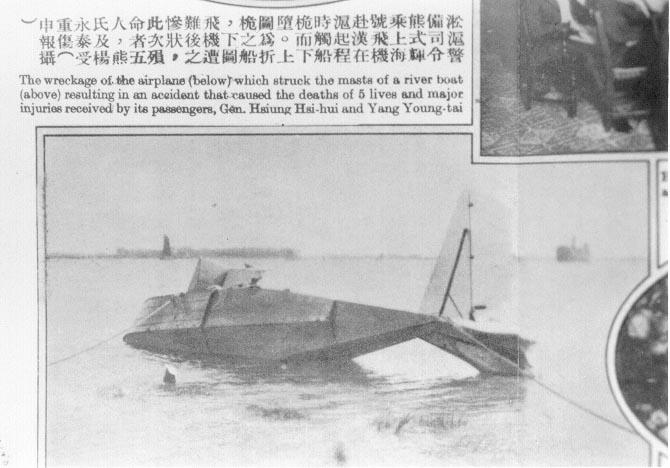|
From The Dragon's Wings, by William Leary "On the morning of December 9, 1930, (Paul F.) Baer, his Chinese copilot-student K.F. Pan, and four passengers boarded a Loening for the scheduled trip to Hankow. Baer taxied into the center of the Whangpoo River, then began his take-off run downstream (south to north), just abeam CNAC's hangers at Lunghwa. The green-painted aircraft (green was the traditional color of the Chinese Postal service) lifted off the water and began to climb straight ahead. A crosswind caused the aircraft to drift to the left. Because of the cowling of the engine on the Loening, the pilot, who sat in the left seat, had little vision to the right and ahead. it is not known whether Baer's copilot ever saw the obstacle. In any event, the lower right wing of the aircraft, close to the fuselage, struck the top of the main mast of a large Chinese junk laying at anchor near the bank of the river. The plane flipped over on its back and plunged into the marshy river bank, upside down, at an angle of approximately 60 degrees. Baer, his copilot, and two passengers perished. The remaining two passengers, including the garrison commander of the Shanghai-Woosung district who was making his first flight, were seriously injured."  October 19, 2001 Dear Tom, Thank you for making such an informative site. I have spent some time researching the aircrafts of CNAC, Eurasia and later CATC. I have found a photo of a Loening crashed in Shanghai. According to your information, I can confirm it is the CNAC Loening crashed on Dec. 9, 1930. The photo is attached. It was published in a magazine called Liang Yo (Good friend). The Loening is named Shanghai according to the Chinese caption. All early CNAC aircrafts were named with Chinese names of places. The names of the two Chinese passengers are Hsiung Hsi-hui (Garrison Commander) and Yang Young-tai. Best regards, Clarence J.P. Fu November 16, 2005 I imagine you noticed that the death of pilot Paul Baer is recounted in the Mathewson article. It gives the date of his demise as 9 December 1930. Another article in the N-CH says he died in 1932, but I imagine the 1930 date is ‘more’ correct. I don’t know if you have a copy of a book on Loenings that has lots of stuff on the CNAC, plus good photos: Loening, Grover. Amphibian: The Story of the Loening Biplane. Greenwich, CN: NY Graphic Society, 1973. Anyway, it says that Baer may have been less than qualified. A pull-no-punches account on page 169: “There were occasions when, by direction of the New York management in the 1929-30 days, a pilot would appear from the States signed up for duty under Allison whom Allison did not know or who had little history of or familiarity with seaplanes, usually none at all with Loenings. This was true of many of the pilots (mostly ex-Army flyers), but they were quickly adaptable—all except Paul Baer, an ex-World War “ace” who had considerable reputation for skill in the war but little else. Allison and Harry Smith were at swords’ points about his qualifications. At any rate, on his first assignment with a passenger load, although he had been amply briefed by other active pilots, he rolled awkwardly down the runway into the river and quite unnecessarily proceeded to take off with a tail wind. The Whangpoo River was crowded with junks and apparently his Chinese co-pilot was not alert, because the horrified onlookers on shore saw the pilots completely overlook a large junk on their right. Baer crashed into its mast. The impact spun him around and threw the whole works into the water, where it turned over, hopelessly sunk. Both crew and passengers were lost. “Ordinarily in aviation such an incident would cast a sickening gloom on the airline and on its hopes for prospective passengers. But in China a few less people in the population meant just that—sadness tempered by relief. And the affair was so clearly pilot carelessness that the airline personnel were not affected except that it emphasized again the importance of two pilots on this type of plane. The blind spot forward of the big engine needed observing from both sides on takeoff. In the air it was not so serious. This type of accident never occurred again in the long history of China National, no doubt because this starter was such a shocker.” The North-China Herald, 22 May 1935, says that Baer’s amphibian did not submerge immediately: “The buoyancy of the main cabin kept the plane afloat for half an hour before she finally filled and settled to the bottom.” Regards, Patti itsahit@istar.ca  or would like to be added to the CNAC e-mail distribution list, please let the CNAC Web Editor, Tom Moore, know. Thanks! |